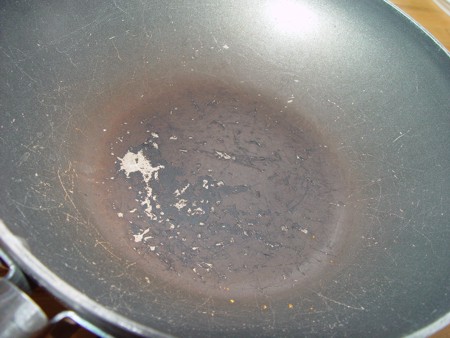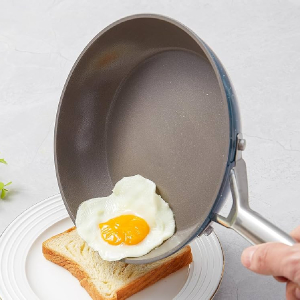That’s the name the social media types crusading against non-stick-coated cookware have given a new ‘disease’ users may contract from cooking with Teflon. It’s potentially serious. Long term affects can include cancer. But you can avoid it…
 A classic disaster: If your Teflon-coated pans look like this…
A classic disaster: If your Teflon-coated pans look like this…
Throw them out!
The crux of the issue
Teflon is the commercial name for the artificial polymer substance Polytetrafluoroethylene (PTFE). It was once heralded as the harbinger of a new anti-stick cooking future. But for some time now, it’s been demonized as a potential source of poisoning for users. It seems the coating breaks down under certain conditions and releases toxic fumes. Those fumes can affect not only cooks but anyone else who’s in the kitchen at the time.
Some folks have reported a range of flu-like symptoms, including fever, chills, headache, fatigue, muscle aches, and dry cough, after using Teflon-coated pans. So common has this phenomenon become that it’s unofficially been dubbed The Teflon Flu.
Long-term effects
It’s just one of a family of similar materials called PFASs. Long term effects of PFAS accumulations in the body may lead to several health concerns, including:
- Increased cholesterol levels
- Low-birth weights in infants
- Decreased vaccine responses
- High blood pressure
- Higher risk of certain cancers
What you can do
First of all, don’t rush to toss your Teflon pans on the scrap heap. The experts tell us ‘out-gassing’ from Teflon cookware occurs when the pans are left dry on the heat, or are used at extremely high temperatures.
Never pre-heat a Teflon-coated pan with nothing in it. “Even if you just start with the butter or oil that you plan to cook your food in, that should be enough to reduce the chances of the coating breaking down,” Shawn Matijevich, chef-instructor of online culinary arts and food operations at the Institute of Culinary Education told Food & Wine .
If you plan to sear or fry at high heat, just use another, non-coated pan.
A simple – I’d have thought obvious – measure you can and should always take when cooking with Teflon is also highly recommended: Just remember to turn on the exhaust fan.
If you have Teflon pans in which the coating has been scratched or is peeling… Just don’t use them. The risk of PFSA ‘shedding’ is increased many-fold when the coating is ‘compromised’.
To avoid compromising your Teflon pans, follow the accepted rules and practices for using them.
And… This seems like an ideal time to remind you that you don’t need to ramp up the heat to cook most everyday foods. Eggs are a prime example…
My take
I tend to think of Teflon pans as ‘historic’. Like so many other serious cooks – I have graduated to high-quality conventional pans. I employ them in the classic French manner, which renders them naturally non-stick.
I have been holding onto an old Teflon-coated ‘breakfast grill’ I got as wedding present, many de-cades ago. Based on what I’ve learned about PFSAs, and the dangers of dry-preheating them, I think I’ll put it out to the trash. There’s an older fellow with rusty old pickup truck who comes around very early in the morning to collect scrap aluminum on garbage day. It’ll make his day!
If you are in love with non-stick cooking, I’d recommend you invest in one or another of the new ‘ceramic’ coated cookware lines. Not a whole set, of course. Just one or two frying or sauté pans in the sizes you use most.
My questions to you:
Do you still use any old Teflon-coated cookware?
Are any of your Teflon pans ‘compromised’?
Do you ever violate any of the ‘safe cooking with Teflon’ rules?
After reading today’s post… Are you more or less likely to replace your old Teflon pans?
Or did the info offered above fail to move you one way or the other?
Muse on that…
~ Maggie J.

